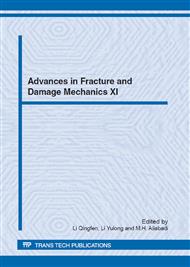p.53
p.57
p.61
p.65
p.69
p.73
p.77
p.81
p.85
Modeling of Damage and Failure of Dual Phase Steel in Nakajima Test
Abstract:
For modern high strength steels, instead of metal instability, ductile damage triggered by the formation of microvoids or microcracks resulting from the complex material microstructure, has become the key factor responsible for the final failure in the forming process of such steels. The target of this study is to describe the initiation and evolution of damage in a dual-phase (DP) steel (DP600). By applying a newly proposed approach that is able to indicate the onset of damage in an engineering sense and quantify the subsequent damage evolution, to predict the forming limits for DP600 are predicted by simulating Nakajima test. Accordingly, two forming limit curves (FLC) are numerically computed to characterize two moments: when damage becomes pronounced and when the final failure is triggered by the accumulation of damage. Comparing with the conventional experimentally calibrated FLC at necking, the limit at crack initiation predicted by modeling gives a lower but defect-free forming boundary. The forming limit at final fracture is well captured by allowing the subsequent damage evolution to a critical value.
Info:
Periodical:
Pages:
69-72
Citation:
Online since:
November 2012
Authors:
Price:
Сopyright:
© 2013 Trans Tech Publications Ltd. All Rights Reserved
Share:
Citation:


